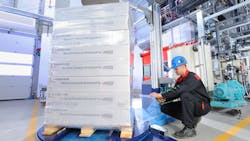CASE STUDY: Designing a reverse osmosis system for real conditions
COLOGNE, GERMANY, APRIL 12, 2017 -- The more accurately a proposed concept offered to a customer takes account of the prevailing circumstances, the easier it is to satisfy the customer's needs. To ensure that the design process of reverse osmosis systems is even more successful in the future, specialty chemicals company LANXESS continuously carries out R&D in the field of water treatment.
Experts from the company presented the latest results – allowing an even better description of the separation behavior of reverse osmosis (RO) membranes under realistic application conditions – at the 3rd International Conference on Desalination using Membrane Technology, on the Spanish island of Gran Canaria from April 2-5, 2017.
Understanding complex correlations
The behavior of RO membranes is determined under realistic service conditions by a large number of parameters. The composition of the feed, for example, is of major importance. In practice, not only the common salt normally used in tests is dissolved in the feed, but other salts too. The rejection for these different salts or ions varies enormously. The pH and the temperature of the salt solution have, for each salt or ion, an individual influence on the success of separation.
In order to gain a better understanding of all these relationships, experts from LANXESS launched a research project that uses modern Design of Experiments (DoE) methods. Only in this way can the number of necessary trials be restricted to a reasonable level even where issues are complex. The goal of the present tests was to gain a better understanding in particular of the behavior of highly crosslinked Lewabrane membranes for the treatment of brackish water. The high crosslinkage level leads to a low effective pore size, bringing about the high rejection ability of these membranes. They are also noted for their high stability even in extreme pH and temperature ranges.
Measurements on salt mixtures
The experts were particularly interested in the separation properties of the membranes for different dissolved salts. Use was therefore made of a test mixture containing not only sodium chloride (2,000 mg/l), but also nitrate (200 mg/l), ammonium (35 mg/l), boron (6 mg/l) and silicate (75 mg/l). Such mixtures are found, for example, in industrial and household effluent, with some components also being found in agriculture, groundwater and seawater.
The separation behavior was examined both on isolated membranes and on complete reverse osmosis elements. The tests were carried out at feed pressures of 10.3 bar and 15.5 bar (low-energy or standard elements) and a yield of 15 percent in a pH range of 3 – 11, and at temperatures of 15 – 35 °C.
To be able to reliably measure the separation behavior in the complete parameter range with as small a number of experiments as possible, use was made of the Design of Experiments (DoE). This was done on the basis of the Response Surface Design method (RSD) in combination with a Central Composite Design (CCD). The evaluation of the experimental results was carried out by adjusting the measuring data to a square model.
The selected target values for the model were total salt rejection, rejection for individually dissolved components and the permeate flow.
Response surfaces for many application scenarios
The response surfaces derived from the test series describe the behavior of the membrane with regard to individual salts or ions over the entire pH and temperature range. For nitrate, for example, there was a clear pH dependence of rejection, with a maximum at pH 7-8 and with only a low dependence on temperature. The results were completely different, for example, with boron, where, in addition to the pH dependence, there was also a marked dependence of rejection on temperature.
The results allow the parameters for RO elements to be specifically selected so that optimal separation results can be obtained for the respective application. "So that we can utilize this potential in the best possible way to the benefit of our customers, the dependency functions obtained are immediately incorporated into the integrated design program, LewaPlus," explains Julien Ogier, head of the technical service laboratory for membranes in the Liquid Purification Technologies (LPT) business unit at LANXESS. "With the present version of LewaPlus, we have been working further on the aspect of user friendliness. For example, during the design of a reverse osmosis system, we can see directly how many simulations have been created for a direct comparison. Apart from that, we have improved the design of the pdf report for the condensate polishing module so that, for the progressive regeneration, the regenerant volume and the application concentration can now also be included," adds Ogier.
The LewaPlus design software can be downloaded free of charge at http://lpt.lanxess.com/en/home/. Detailed information on the products of the LANXESS LPT business unit can also be found there.
LANXESS is a leading specialty chemicals company with sales of EUR 7.7 billion in 2016 and about 16,700 employees in 25 countries. The company is currently represented at 54 production sites worldwide. The core business of LANXESS is the development, manufacturing and marketing of chemical intermediates, specialty chemicals and plastics. Through ARLANXEO, the joint venture with Saudi Aramco, LANXESS is also a leading supplier of synthetic rubber. LANXESS is listed in the leading sustainability indices Dow Jones Sustainability Index (DJSI World) and FTSE4Good.
RELATED ARTICLES
Reverse osmosis membrane manufacturing to double in Germany, commits LANXESS
